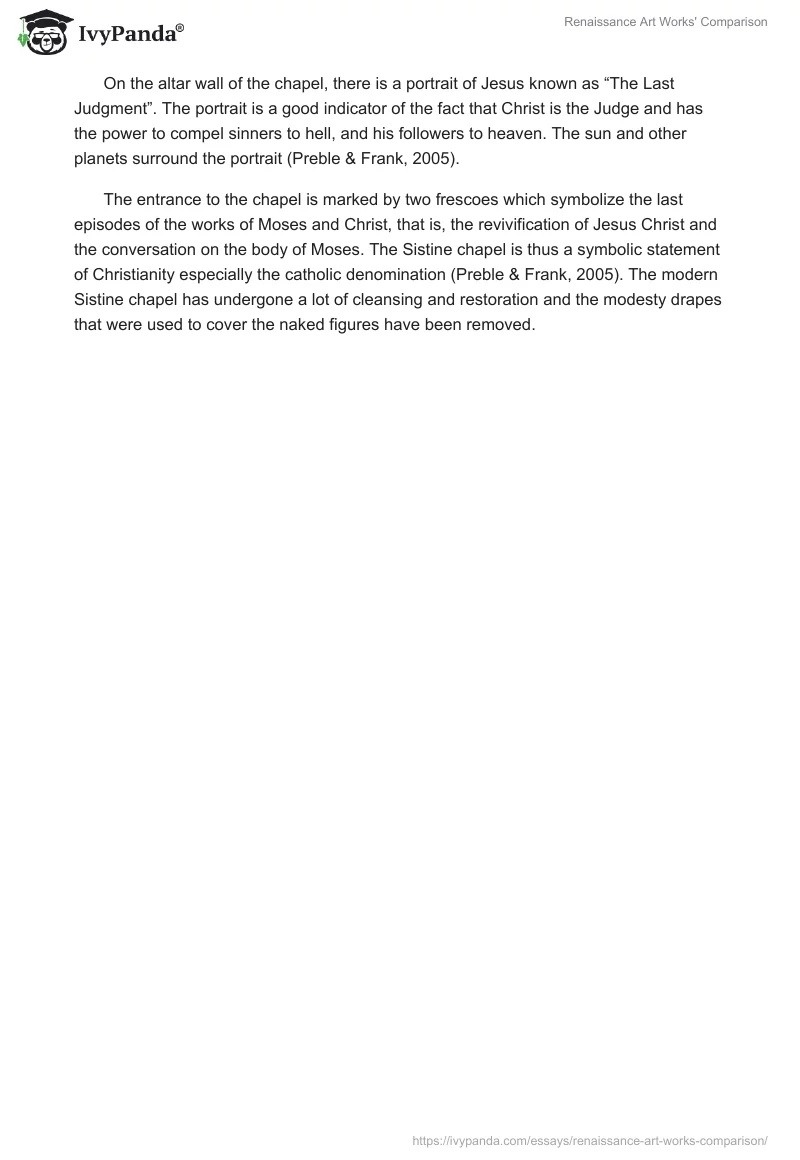Introduction
Artworks differ significantly across different fields and periods. Some artworks have originated from the minds of individuals or social and ethnic influences while others have been influenced by the designs and features of earlier art periods.
Renaissance is a historical art period during which art was revitalized in the western world. The shift from the classical period to the Renaissance period took place during the 4th century BC. The social condition, which contributed to the advent of the renaissance style, is the increase in territorial tussle taking place across Europe. With the exclusion of the Catholic Church, the people had to dedicate themselves to the comfort of art. They, therefore, outrightly discarded classical art with an emphasis on religious convictions and this led to the rise of renaissance art (Boyle, 2001). This paper will compare and contrast two Renaissance works of art, one appearing on a website and the other appearing in a textbook.
Discussion
The Sistine chapel
The Sistine Chapel is an example of a Renaissance artwork in the book “Preble’ Artforms: An Introduction to the Visual Arts” by Preble & Frank, 2005. The chapel is located in the Vatican and is one of the most illustrious artworks in the western world. It is named after Pope Sixtus IV, who commissioned its construction in 1475. The chapel is rectangular shaped is three dimensional and is made out of marble and bronze. Its dimensions are similar to those of the Temple of Solomon as shown in the Old Testament. The piece of artwork is surrounded by wall frescoes with the left wall symbolizing events in the Old Testament and the right wall portraying those in the New Testament. Portraits of God’s followers such as Peter are evident in the chapel and these symbolize God’s given authority. The chapel’s ceiling is divided into nine parts which symbolize the nine stories in the book of Genesis, from creation to Noah’s Drunkenness (Preble & Frank, 2005).
On the altar wall of the chapel, there is a portrait of Jesus known as “The Last Judgment”. The portrait is a good indicator of the fact that Christ is the Judge and has the power to compel sinners to hell, and his followers to heaven. The sun and other planets surround the portrait (Preble & Frank, 2005).
The entrance to the chapel is marked by two frescoes which symbolize the last episodes of the works of Moses and Christ, that is, the revivification of Jesus Christ and the conversation on the body of Moses. The Sistine chapel is thus a symbolic statement of Christianity especially the catholic denomination (Preble & Frank, 2005). The modern Sistine chapel has undergone a lot of cleansing and restoration and the modesty drapes that were used to cover the naked figures have been removed.

The Pieta
The Pieta is a good example of a Renaissance artwork by Michelangelo Buonarroti. The piece of architecture is located in the Vatican and is carved from marble. It is considered to be one of the most attractive works by Michelangelo and was commissioned in honor of Jean de Billheres, who was the French cardinal by then. It symbolizes the body of Christ on the lap of Mary, his mother. The artist’s interpretation of the sculpture is unique compared to other artists.
The sculpture is three dimensional and has a pyramidal shape. It broadens progressively towards the hangings of Mary’s dress and her figures are arranged in a manner that they seem to be out of proportion. Michelangelo by carving the sculpture did not want the Pieta to symbolize death but to reveal the “religious vision of abandonment and a serene face of the Son” (Buonarroti, 1995).
Mary’s youthful looks and the still facial appearance, together with the position of the upper limbs symbolize the fact that she is seeing her son. The fact that the sculpture depicts Mary to be very young also symbolizes her moral uprightness. The small size of Jesus Christ as manifested in the statue illustrates Jesus’ feebleness though in a state of death.

Conclusion
The above two works of art fit into the context of the Renaissance period. This is because the greatest theme of artworks during this historical art period was the supremacy of the church and the emergence of Christianity. The devil by representing the powers of darkness and wickedness was a strong force in renaissance thinking and the church controlled such fears by changing the pagan world of the early renaissance period. Other changes that were seen in the two artworks, which make them, fit in the context of the Renaissance period is the presence of a new system of docks and cellars. This has changed the usual rounded places of worship to pointed ones hence allowing for enlargement of the edges of sacred structures. This has also led to the development of a rectangular region for the most active members of the church and especially the clergy. These characteristics are evident in the above two artworks since the two reveal these paradigmatic changes and exhibit ideas of humanism and naturalism. It is, therefore, clear that the two sculptures were done during the renaissance period.
References
Boyle, D. (2001). Renaissance Art: A Crash Course. Dubuque: Brown Company Publishers.
Buonarroti, M. (1995). The Pieta in the Pallazzo. Madison: Wisc Editions Publishers
Preble, D., & Frank, P. (2005). Preble’ Art forms: An Introduction to the Visual Arts. Upper Saddle River: Pearson Publishers.


